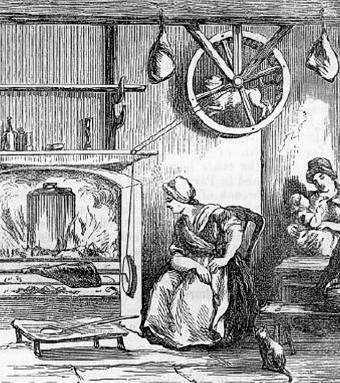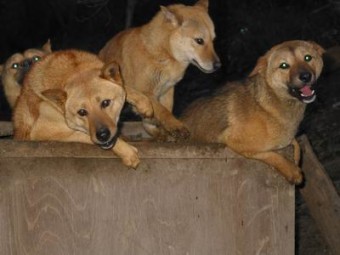The Curious Tale of Turnspit Dogs
Considering how most dogs in the Western world these days are treated as a member of the family, it’s often easy to forget that the vast majority of our furry friends up until very recently were bred for a specific purpose. Perhaps no dog was bred for a more specific purpose than the now extinct, turnspit.
The turnspit was so named because it was literally bred just to run for hours on a tiny wheel that turned a spit. No, really, that was all it did. You see, a few hundred years ago the generally preferred method for cooking a large piece of meat evenly was to put it on a spit and rotate it until it was fully cooked. Cooking meat thoroughly on a spit takes anywhere between 40 and 80 minutes per kilo depending on which meat it is you’re cooking. Needless to say, roasting an adult hog on the fire for a party took an incredibly long time.
Prior to the introduction of turnspits around the 16th century, the painstakingly tedious and unrelenting job of turning the spit was left to the lowest ranking member of the household, “usually a small boy“, though in larger households the size of the spit necessitated delegating the job to an adult. The job was tough, cruel and often resulted in the poor soul tasked with doing it suffering from burns, blisters and exhaustion. What made the job more difficult was that the spitjacks, as they were known, had to work in full uniform. In fact, during Tudor times, spitjacks working in Hampton Court were told that they had to stop working in the nude as well as to stop urinating in the fireplace.
While we’d like to say that spitjacks were replaced by dogs out of concern for their health, the truth is that dogs could work longer hours without a break and they didn’t need to be paid in anything other than food. This is why in 16th century, spitjacks were phased out in favour of a small machine powered by an even smaller dog.
So were the dogs treated any better than the spitjacks? Nope. Turnspits were generally seen more as kitchen tools than fuzzy members of the household who needed just as many belly rubs and chin scratches as normal dogs. Along with being subjected to the same long hours and awful conditions as the human spitjacks before them, turnspits would often be cruelly mistreated by their owners. For instance, to train them to run at the correct speed, a common method was simply to throw a hot coal into the dog’s wheel every time it slowed too much. During their off-time, the exhausted turnspits were known to work great as footwarmers.
Turnspits were ultimately replaced by steam-powered machines and by the end of the 19th century the breed officially was declared extinct. Intriguingly, it appears that people from the early 19th century were well aware that the turnspit breed wasn’t going to last. For example, in the book, Memoirs of British Quadrupeds, published in 1809, in regards to the turnspit the author wrote “It is now on the decline; and, in the course of another century it will probably be extinct in Great Britain“, which mirrors the breed’s actual fate almost perfectly.
Despite the fact that, for a few centuries, the turnspit could be found in almost every large home in England, including the homes of royalty, nobody anywhere bothered to note down exactly what breeding process went into creating the dog that had ensured so many people had evenly cooked dinners. All we have to go on are historical descriptions of the breed which described it as “long-bodied”, “crooked-legged” and “ugly”. We also have a single stuffed specimen called Whiskey.
It’s not all bad though; the horrific treatment turnspits were subjected to is reportedly what inspired Henry Bergh to start the American Society for the Prevention of Cruelty to Animals, which in turn has resulted in countless animals being saved from abuse and cruelty.
If you liked this article, you might also enjoy our new popular podcast, The BrainFood Show (iTunes, Spotify, Google Play Music, Feed), as well as:
- Why Chocolate is Bad for Dogs
- Why are Grapes Bad for Dogs?
- Dogs and Cats are Typically Right or Left Pawed
- A Dog’s Mouth is Not Cleaner Than a Human’s Mouth
- Both Cats and Dogs can See Color
Bonus Facts:
- Dogs are commonly eaten in Asia with around 13-16 million dogs eaten every year there, or around nearly 4% of the world’s dog population. Typical breeds you’d find in people’s households as pets are not the ones usually eaten. Rather, specific breeds have been developed for consumption, such as the hugely popular Nureongi dog (pictured right), which is rarely raised for anything else but livestock and is one of the most popular dog breeds to eat.
- In South Korea, both dogs meant to be pets and dogs meant to be eaten can often be seen sold in the same marketplace. Usually the cages the dogs are kept in will be marked or color coded to distinguish which dogs are for what purpose.
- Domestic dogs are descended from the gray wolf at least 15,000 years ago (and possibly further back as the 15,000 year ago mark was just when it is thought the domestic dog diverged from the gray wolf). Dogs were also probably the first animal to be domesticated, likely due to their high utility, such as helping in hunting and as work animals. They are also somewhat predisposed for domestication due to their extremely sophisticated social cognition abilities, rarely found in any animal outside of humans.
- Like with the domestic house cat, it isn’t known whether the dog was purposefully domesticated by humans or if they were self-domesticated, with certain of the gray wolves becoming friendly with humans from continually scavenging food scraps around human camps. Also, similar to the domestic cat that all likely descended from just a handful of cats, it is thought that all dogs descend from just a handful of gray wolves in a small number of domestication events. In the dog’s case, this probably took place in East Asia, with the dogs quickly being bred and spreading throughout the world, even to North America around 10,000 years ago.
- Due to the long hours they were subjected to, turnspits often worked in pairs, with one working while the other rested.
- Turnspits were first classified as their own unique breed in 1576 by Johannes Caius, the royal physician at that time.
- Along with working machines that turned spits, turnspits were sometimes used to power machines that pressed cider and pumped water.
- The turnspit was known by a number of alternate names including the kitchen dog and the Vernepator Cur, which is Latin for “the dog that turns the wheel”. The breed’s scientific name is Canis vertigus, which literally translates to “dizzy dog”.
| Share the Knowledge! |
|







4 comments